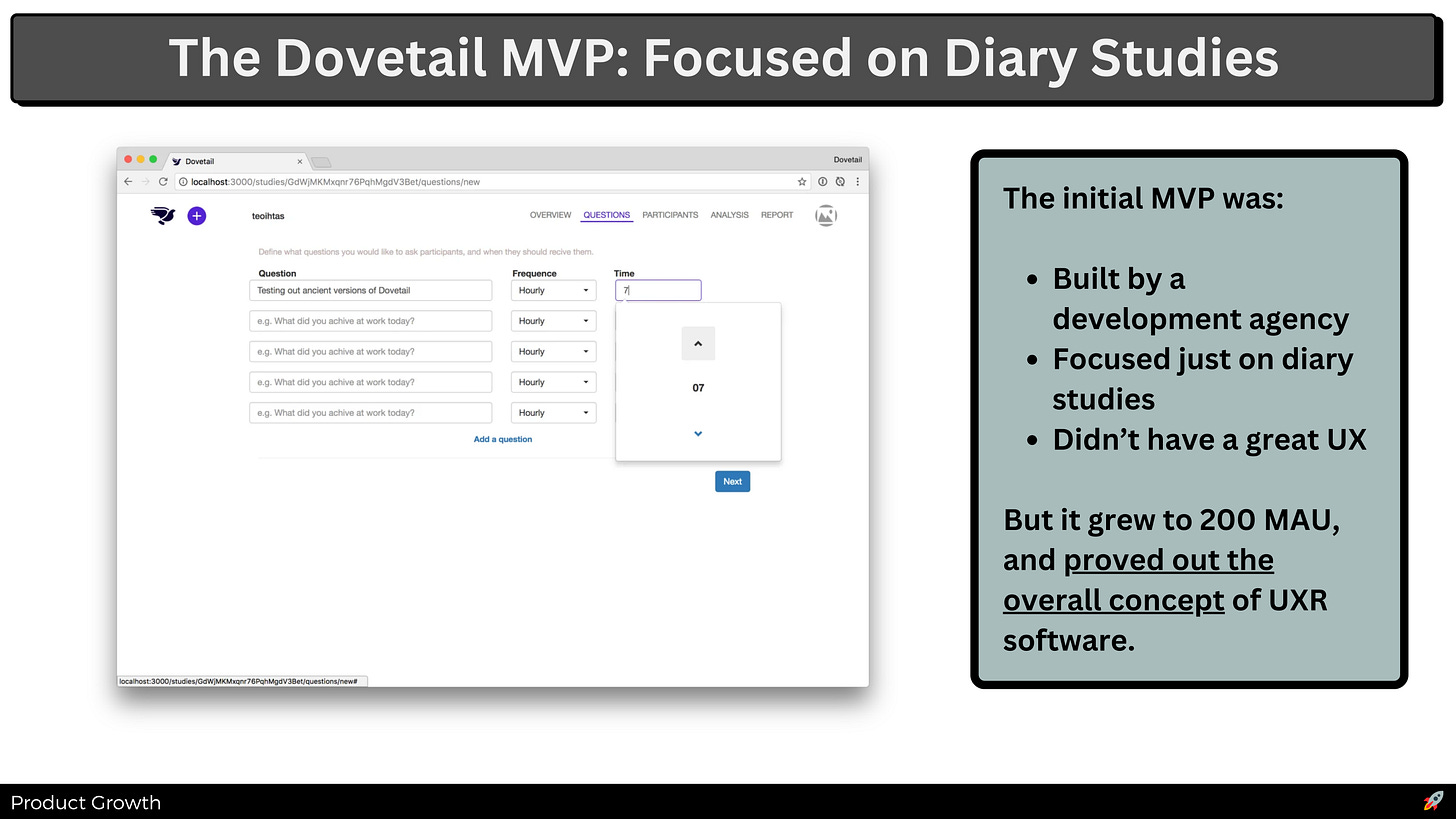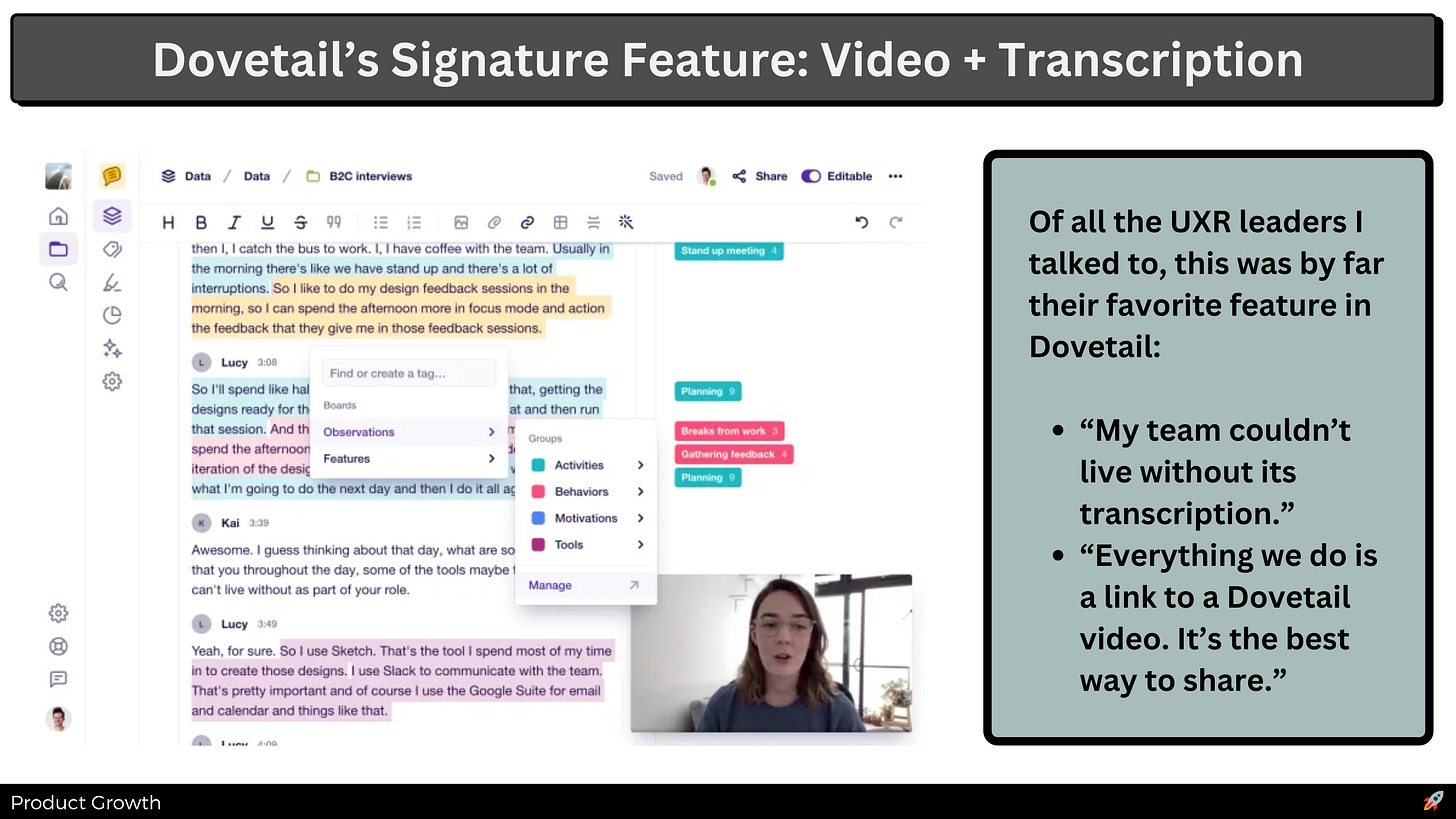How Dovetail Grows
The story and PLG breakdown of Australia’s next big tech company
I’m excited to present what I believe is the web’s first deep dive on a fast-growing PLG B2B SaaS with a valuation of $970M AUD. A company with clients like Google, Notion, and Shopify.
And it’s all powered by a series of exclusive interviews with the Dovetail team—including VP of Product Srinivas Krishnamurti, CEO Benjamin Humphrey, Content Lead Caitlin Burns, and Product Marketing Lead Alissa Lydon.
I also picked the brains of 4 user research leaders who have paid for the product.
Coming out of all this work, I’m convinced that Dovetail is one of the most interesting tech companies on the planet right now.
Let’s dive in.
Today’s Post
Words: 5,054 | Est. Reading Time: 22 Mins
The story of Dovetail
The 8 layers of Dovetail’s PLG motion
How Dovetail builds Product: inside the company
How Dovetail wins in a crowded market
The future of Dovetail
1. The story of Dovetail
Chapter 1 - Founding
The year was 2017. Benjamin Humphrey was working as a designer at Atlassian, the original PLG giant in Australia.
As part of his design work, he frequently worked on user research projects, but never found the process fun.
Unlike all the other functions, user researchers had no tool:
Engineers had Jira
Designers had Sketch
Product Managers had Confluence
But what was there for User Research? The process was clunky and cumbersome. You had to hop between spreadsheets, physical whiteboards with sticky notes, UserTesting, and other bespoke tools.
It was a mess.
While so many amazing tools exist to help you build something, I just felt like there weren’t tools to tell you what to build.
—Benjamin Humphrey, CEO
Recognizing this gap, Benjamin had the vision to build a tool that could do for User Research what Figma did for design: give user research a web-based, central, and collaborative hub for work.
But, he didn’t start with such a grand vision.
Starting Small: Tackling Diary Studies
To start, he decided to just tackle diary studies. He hired an Upwork agency to get a prototype in 4 weeks. It looked like this:
The MVP was very simple.
And it showed early promising signs. Two months after launch, Dovetail had 200 users, with 40 of them active and running studies on a weekly basis (WAU).
The initial traction was enough for Ben to be able to convince his engineering colleague from Atlassian, Bradley Ayers, to join the team as co-founder and CTO.
A Lifestyle Business, Not a Unicorn
The duo’s dream was to create a small, lifestyle business.
It wasn’t to go big:
We were in agreement that we wanted a lifestyle business—something to pay the bills, something that would be fun, something customers would love. Early on, scaling the team beyond a handful of people wasn’t something we were hoping for let alone expecting.
—Bradley Ayers, CEO
Chapter 2 - PLG from the Start
And that was a reasonable expectation. Success was far from guaranteed.
Even if Dovetail’s precise idea hadn’t been built yet, the research and insights software space was crowded. Researchers used:
UserTesting, UserZoom, and Qualtrics for getting data
Optimal Workshop, EnjoyHQ, and CAQDAS software for research hubs
Airtable and Miro for centralization
How could a couple of first-time founders with an MVP compete?
Going Back to the Drawing Board
It started with the MVP they had. Looking at the data, Ben and Bradley noticed that users would finish their diary study and cancel.
So, they went back to the initial 200 customers and did detailed user research.
It was a full-blown process, done on Dovetail:
They did discovery
They did concept testing
They even shared shared product design sketches over video and did co-design sessions
The result of all that work?
They realized that the whole product had to be reworked, from the ground up.
Launching Dovetail 2.0
So, they rewrote Dovetail and launched Dovetail 2.0. It looks quite a bit like the Dovetail we know today:
Dovetail 2.0 is quite similar to Dovetail today—just with less features.
The key feature set was: you could tag insights from an interview and survey, easily aggregate that into insights, and then share it with your team.
It was simple. But simple was good. Because it was a real problem for user researchers. And the product solved it.
The Key to Initial Success
The real key to Dovetail’s initial success was: it borrowed design paradigms from expensive CAQDAS research software that user researchers, many of whom were formerly PhDs, were used to using.
But it offered it at a fraction of the price. And it was in the cloud.
And it had all the business features on top. Indeed, the team kept shipping them at a furious pace:
Per-project access controls
Domain-restricted signup
Notion-like formatting
Slack integration
CSV export
PLG Playbook: Doing More with Less
They didn't have a sales team or a huge marketing budget. Instead, they took a page from their Atlassian-days and used the product-led growth (PLG) playbook.
It worked:
Even when it was just me and Bradley, we got inbound from big customers like Google, Amazon, and the US Air Force.
—Benjamin Humphrey, CEO
Chapter 3 - Rapid Growth
The PLG growth model worked. Growth came at a brisk pace. The team continued to grow. And they continued to ship more.
In 2020, the company shipped one of its signature features: video and transcription.
You can drop in your conversation with customers, and it will transcribe it, and also tag the sentences for sentiment:
The feature would prove to be transformative and a hook future UXR teams to use the tool. Hours transcribed even become the team’s main upgrade lever for a time (the free plan had a 2 hour limit).
From Lifestyle to VC-backed
Growth was so fast that the team sniffed opportunity:
We reached the point where we could afford to pay ourselves something, or hire another member of the team.
We took the path of the unfamiliar and decided to see how we could make this bootstrapped lifestyle business a little more interesting and began to build our team and then later took another leap and took seed funding.
—Bradley Ayers, Former CTO
Dovetail’s roots as a lifestyle business helped the company grow in a way that it didn’t necessarily “need” funding.
It was profitable(ish) and growing fast.
This made it all the more sexy to investors.
And so, the team changed their strategy, and raised:
A seed round
A seed-1 round at more than a $150M (Australian) valuation
Followed by a massive $960M valuation when Dovetail finally raised its series A
From 20 to 100: Beefing Up the Team
With an additional $89M AUD in the bank, the company grew quickly.
It beefed up its GTM office in San Francisco to 20, and the Australian office grew to ~80. The company ended 2023 with ~100 employees.
Chapter 4 - Product Expansion
As most companies do after raising funding, Dovetail’s aspirations grew considerably.
And the company noticed people like me were using it. (Indeed, I was using it as a Head of Product Growth at Affirm.)
This began the company’s product expansion to all parts of the lifecycle for user researchers:
Helping you analyze data and break it into key points
Regrouping it into themes
Creating summaries
Sharing and presenting to stakeholders
The Power of the PLG Flywheel
This worked. As more user researchers adopted the product, the flywheel began to spin. They loved it:
Research that used to be scattered across different tools was now centralized
Tagging and search made it easy to surface relevant insights
Collaboration features brought together designers, product managers, and other stakeholders
So, they told their friends. And the product grew.
I’ve actually helped Dovetail get 4 more customers. I recommend it to all my user research friends. There’s just no other software out there that gets the challenges of modern researcher.
—3x UXR leader
Over time, Dovetail went from a nice-to-have to a must-have. Individual users became teams. Teams became departments.
And the virtuous cycle of PLG continued.
Chapter 5 - Dovetail Today
Today, Dovetail has grown to serve over 4,000 customers and 250,000 users, including the top product companies in the world—like Netflix, Shopify, and Canva.
And it’s not just tech companies that use Dovetail. It has clients in the government (UK), in regulated industries like health care (AstraZeneca) and finance (RBS), and in stodgy old research institutions like universities (Harvard).
Evolving with the Times
It has had this success, because the company keeps evolving. Notably, a few months ago, co-founder Bradley Ayers left. And the company parted ways with its PMs and growth team to return to its design-led roots (more on that in Section 3).
And, like every other SaaS, Dovetail has implemented its own version of AI in the product.
The Rise of AI
AI has now made it into the main screens of Dovetail’s most visited pages. AI can help you not just with transcription, but also summarization, highlights, and clustering.
As much as we love AI, it’s still not very accurate and 100% there. So the approach we have taken to the experience is that you as the user, can tweak it. We do 80% of the work for you.
—Srinivas Krishnamurti, VP of Product
Yet, even as Dovetail evolves rapidly, the PLG DNA that powered the early days remains as vital as ever. Growth is still primarily driven by product usage and word-of-mouth.
Dovetail: The Story of PLG
As a result - in many ways, the story of Dovetail is the story of PLG itself: a obsessive focus on the end user, a commitment to making the product as accessible and valuable as possible, and a belief that if you build something truly great, the rest will follow.
It's a story that's still being written, but one that offers valuable lessons for any founder or PM.
Read on for a breakdown of the actual product (section 2), a look at how it builds product (section 3), its competition (section 4), and predictions for the future (section 5)…
Keep reading with a 7-day free trial
Subscribe to Product Growth to keep reading this post and get 7 days of free access to the full post archives.










